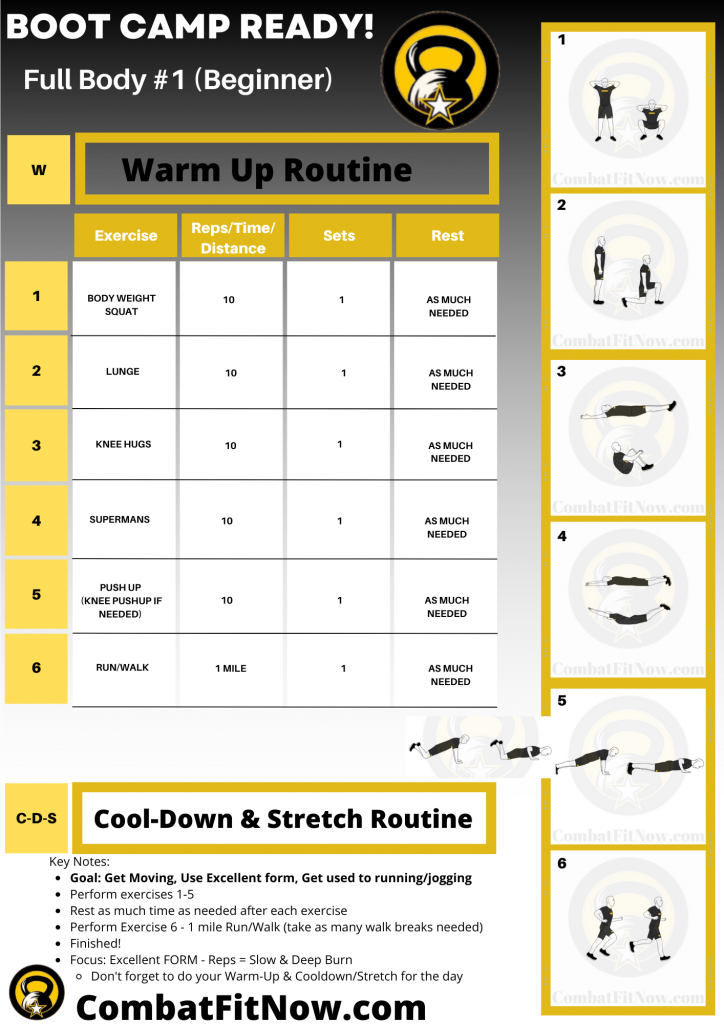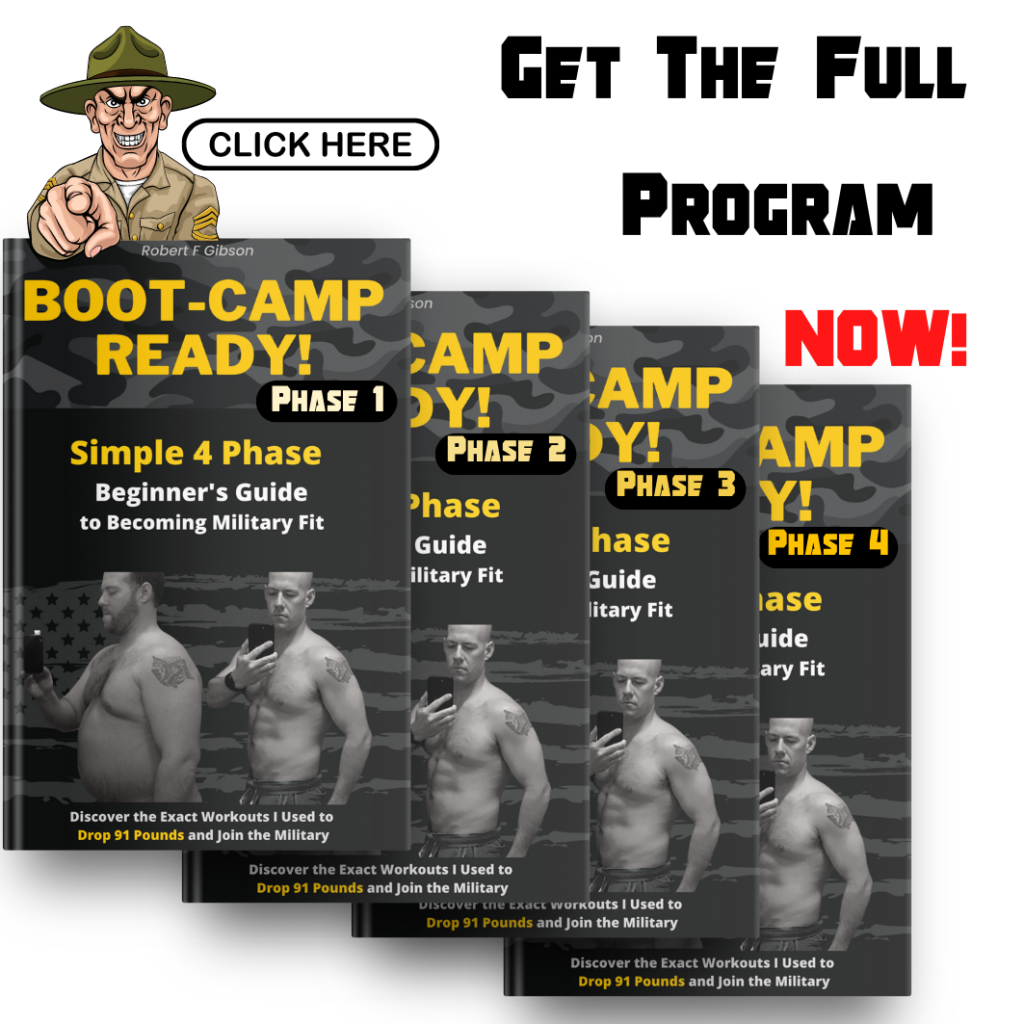Summary of Basic Training Workout #1: Full Body
| Exercise | Reps | Sets | Rest |
| Bodyweight Squat | 10 | 1 | As Much Needed |
| Lunge | 10 | 1 | As Much Needed |
| Knee Hugs | 10 | 1 | As Much Needed |
| Supermans | 10 | 1 | As Much Needed |
| Push Ups | 10 | 1 | As Much Needed |
| Run/Walk | 1 mile | 1 | As Much Needed |
Description & Benefits of Basic Training Workout #1: Full Body
This workout routine is designed to prepare beginners for basic training in the military. Here’s an explanation of why each exercise is beneficial for such preparation:
- Bodyweight Squat (10 reps, 1 set):
- Benefit: Squats are a fundamental lower body exercise that helps build strength in the quadriceps, hamstrings, and glutes. They mimic sitting down and standing up, a movement pattern often used in military training.
- Lunge (10 reps, 1 set):
- Benefit: Lunges work on the muscles of the legs, especially the quadriceps, hamstrings, and glutes. They also engage the core for stability. Lunges simulate the stepping and lunging motions often required in military drills.
- Knee Hugs (10 reps, 1 set):
- Benefit: Knee hugs are a dynamic stretching exercise that helps improve flexibility and mobility, particularly in the hip flexors and lower back. This can be beneficial for marching and running movements, which are common in military training.
- Supermans (10 reps, 1 set):
- Benefit: Supermans target the lower back, glutes, and upper back muscles. Strengthening these muscles improves posture and stability, crucial for carrying equipment and maintaining a solid and upright position during various military exercises.
- Push Ups (10 reps, 1 set):
- Benefit: Push-ups are a classic upper body exercise that works the chest, shoulders, triceps, and core. They help build upper body strength, essential for activities like carrying a backpack or other equipment during basic military training.
- Run/Walk (1 mile, 1 set):
- Benefit: Running and walking are essential cardiovascular exercises that improve endurance, a key component of military fitness. Basic training often involves running or marching long distances, so cardiovascular endurance is crucial for overall wellness and performance.
Rest:
- Benefit: Allowing for as much rest as needed between sets is essential for beginners to avoid overexertion and reduce the risk of injury. It also helps in maintaining the quality of each exercise.
Overall, this workout covers a range of movements and muscle groups, providing a well-rounded approach to physical fitness. The combination of strength training, flexibility exercises, and cardiovascular activity makes it suitable for individuals preparing for the physical demands of basic military training. It’s essential for beginners to start gradually and progressively increase the intensity of their workouts as they build strength and endurance.
Benefits of Full Body Workouts
Full-body workouts are often recommended for beginners preparing to get into military shape for several reasons:
- Functional Strength Development:
- Full-body workouts engage multiple muscle groups in a single session. Full body workouts mimic the demands of military training, which often requires individuals to use their entire body for various activities like running, climbing, lifting, and carrying equipment. Functional strength development is crucial for military readiness.
- Efficiency:
- Full-body workouts are time-efficient. Since they target different muscle groups in one session, individuals can achieve comprehensive training faster than focusing on specific muscle groups on other days. This benefits those with busy schedules, which is common in military training environments.
- Cardiovascular Conditioning:
- Military training involves cardiovascular endurance for running, rucking, and other aerobic exercises. Full-body workouts incorporating compound movements (activities involving multiple joints and muscle groups) can contribute to cardiovascular conditioning, helping beginners build the stamina required for military fitness.
- Adaptation to Varied Environments:
- Military training often occurs in unpredictable and challenging environments. Full-body workouts help individuals develop strength and coordination that can be adapted to various situations, essential in the military, where soldiers may encounter different terrains and obstacles.
- Movement Patterns:
- Military activities involve various movement patterns, from lifting and carrying heavy loads to agility and quick directional changes. Full-body workouts ensure that individuals develop strength and flexibility across different movement patterns, preparing them for the physical demands of military service.
- Practicality and Simplicity:
- Full-body workouts are often simple to design and execute. This simplicity can be advantageous for beginners new to fitness training. It reduces the complexity of workout routines, making it easier for individuals to adhere to a consistent exercise regimen.
- Reduced Risk of Overtraining:
- Full-body workouts allow beginners adequate rest between sessions for specific muscle groups. This can help reduce the risk of overtraining and decrease the likelihood of injuries, allowing individuals to progress at a steady and sustainable pace.
- Foundational Strength:
- Full-body workouts build a strong foundation of overall strength, which is crucial for military readiness. This foundation provides a solid base for individuals to progress to more specialized training.
Remember, while full-body workouts are beneficial, it’s essential to complement them with proper nutrition, sufficient rest, and specific skill-based training to prepare for the demands of military service fully. Always consult with a fitness professional or healthcare provider before starting any new exercise program, especially if you’re a beginner or have pre-existing health conditions.


